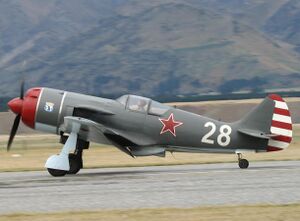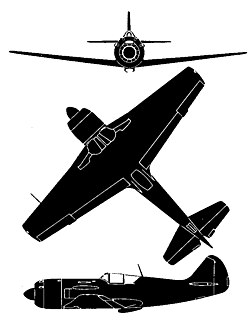Engineering:Lavochkin La-9
| La-9 | |
|---|---|

| |
| Role | Fighter |
| Manufacturer | Lavochkin |
| First flight | 1946 |
| Introduction | August 1946 |
| Status | Phased out of service |
| Primary users | Soviet Air Force Romanian Air Force North Korea Air Force |
| Produced | 1946–1948 |
| Number built | 1,559 |
| Variants | Lavochkin La-11 |
The Lavochkin La-9 (NATO reporting name Fritz) was a Soviet fighter aircraft produced shortly after World War II. It was one of the last piston engined fighters to be produced before the widespread adoption of the jet engine.
Development
La-9 represents a further development of the Lavochkin La-126 prototype. The first prototype, designated La-130 was finished in 1946. Similarity to the famous Lavochkin La-7 was only superficial – the new fighter had an all-metal construction and a laminar flow wing. Weight savings due to elimination of wood from the airframe allowed for greatly improved fuel capacity and four-cannon armament. Mock combat demonstrated that the La-130 was evenly matched with the La-7 but was inferior to the Yakovlev Yak-3 in horizontal planes. The new fighter, officially designated La-9, entered production in August 1946. A total of 1,559 aircraft were built by the end of production in 1948.
Variants
Like other aircraft designers at the time, Lavochkin was experimenting with using jet propulsion to augment performance of piston-engined fighters. One such attempt was La-130R with an RD-1Kh3 liquid fuel rocket engine in addition to the Shvetsov ASh-82FN piston powerplant. The project was cancelled in 1946 before the prototype could be assembled. A more unusual approach was La-9RD which was tested in 1947–1948. It was a production La-9 with a reinforced airframe and armament reduced to two cannons, which carried a single RD-13 pulsejet (the engine which powered the V-1 flying bomb, probably taken from surplus Luftwaffe stocks) under each wing. The 70 km/h (45 mph) increase in top speed came at the expense of tremendous noise and vibration. The engines were unreliable and worsened the handling. The project was abandoned although between 3 and 9 La-9RD were reported to perform at airshows, no doubt pleasing the crowds with the noise.
Other notable La-9 variants were:
- La-9UTI – two-seat trainer version. Built at GAZ-99 in Ulan-Ude. Two versions exist: with 12.7 mm UBS machine gun and with one 23 mm NS-23 cannon (all armament is mounted in the cowling above the engine, firing through the propeller).
- La-132 (La-132) – prototype with upgraded Shvetsov M-93 engine. Projected top speed 740 km/h (460 mph) at 6,500 m (21,325 ft). Engine proved a failure and the single prototype was equipped with an experimental Shvetsov ASh-82M instead. The aircraft did not proceed to production.
- La-9M (La-134) – long-range fighter prototype, see Lavochkin La-11
- La-9RD – one La-9 was fitted with two auxiliary RD-13 pulsejet engines underwing.
- La-138 – one La-9 was fitted with two underwing PVRD-450 auxiliary ramjet engines.
Operators
- People's Republic of China
- People's Liberation Army Air Force Imported 129 La-9 airplanes in 1950. The last 5 La-9 fighters retired in 1959.
- East Germany
- Volkspolizei (5 operated from 1952 to 1956 prior to the formation of the Air Forces of the National People's Army)
- North Korea
- Romania
- Romanian Air Force (10 delivered in 1950: 5 La-9 and 5 La-9 UTI)
- Soviet Union
- Soviet Air Force
- Soviet Air Defence Forces
Surviving aircraft
China
- La-9 6201 is on display at Beijing Aeronautical Institute, Beijing, China as 7504
- La-9 (unidentified S/N) on display at People's Liberation Army Air Force Museum, Datangshan, Chiangping, China as 06
- La-9UTI (unidentified S/N) on display at People's Liberation Army Air Force Museum, Datangshan, Chiangping, China
North Korea
- La-9 102 is on display at Glorious Fatherland Liberation War Museum, Pyongyang, North Korea[1]
Romania
- La-9 66 on display at Central Military Museum, Bucharest, Romania
United States
- La-9 28 owned by Jerry Yagen's Military Aviation Museum and restored by Pioneer Aero Restorations in New Zealand between 2001 and 2003, airworthy as N415ML
Specifications (La-9)
General characteristics
- Crew: 1
- Length: 8.63 m (28 ft 4 in)
- Wingspan: 9.8 m (32 ft 2 in)
- Height: 3.56 m (11 ft 8 in)
- Wing area: 17.6 m2 (189 sq ft)
- Aspect ratio: 5.46
- Airfoil: TsAGI Laminar Airfoil [2]
- Empty weight: 2,638 kg (5,816 lb)
- Gross weight: 3,425 kg (7,551 lb)
- Max takeoff weight: 3,676 kg (8,104 lb)
- Powerplant: 1 × Shvetsov ASh-82FN 14-cylinder air-cooled radial piston engine, 1,380 kW (1,850 hp) with 1-stage 2-speed supercharger and fuel injection
- Propellers: 3-bladed constant-speed propeller
Performance
- Maximum speed: 690 km/h (430 mph, 370 kn) at altitude
- Range: 1,735 km (1,078 mi, 937 nmi)
- Service ceiling: 10,800 m (35,400 ft)
- Rate of climb: 17.7 m/s (3,480 ft/min)
- Wing loading: 150 kg/m2 (31 lb/sq ft)
- Power/mass: 0.40 kW/kg (0.24 hp/lb)
Armament
- Guns: 4 × 23 mm Nudelman-Suranov NS-23 cannon, 75 rpg
See also
Related development
Aircraft of comparable role, configuration and era
- Grumman F8F Bearcat
- Hawker Sea Fury
- Hispano Aviación HA-1112
- Nakajima Ki-84
- Kawasaki Ki-100
- North American P-51 Mustang
- Vought F4U Corsair
Related lists
References
- ↑ "Aviation Photo #0861812: Lavochkin La-9 - North Korea - Air Force". 9 May 2005. https://www.airliners.net/photo/North-Korea-Air-Force/Lavochkin-La-9/861812/L?qsp=eJwtjUEKAjEQBL8ic9aDCIJ70w/owQ8Mk8YNGzdhMqhh2b87Bm9FddO9kOTZ8LF7K6CBKlhlpC0VVn5WGhaa0N5ZgzMlfmUZpzhvEu9O3qpZ7dI8CWw4i6AYwt9fNUB/Ear0wYcf7B2gt850OLoPsZbEfQPGMdG6fgHvszGt. Retrieved 6 October 2019.
- ↑ Lednicer, David. "The Incomplete Guide to Airfoil Usage". https://m-selig.ae.illinois.edu/ads/aircraft.html. Retrieved 16 April 2019.
Further reading
- Gordon, Yefim. Lavochkin's Piston-Engined Fighters (Red Star Volume 10). Earl Shilton, Leicester, UK: Midland Publishing Ltd., 2003. ISBN:1-85780-151-2.
- Green, William. War Planes of the Second World War, Volume Three: Fighters. London: Macdonald & Co.(Publishers) Ltd., 1961. ISBN:0-356-01447-9.
- Kopenhagen, W (ed.), Das große Flugzeug-Typenbuch (in German). Transpress, 1987, ISBN:3-344-00162-0.
The initial version of this article was based on material from aviation.ru. It has been released under the GFDL by the copyright holder.
 |


